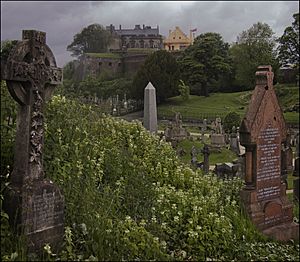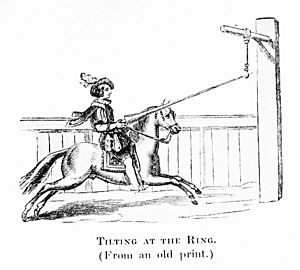Running at the ring facts for kids
Running at the ring, also known as riding at the ring or tilting at the ring, is an exciting horse-riding game. It's a bit like a jousting tournament but instead of hitting another rider, you try to catch a small ring with your lance. This sport was popular in European royal courts a long time ago. It became popular again in the 1820s in Natural Chimneys near Mount Solon, Virginia. Since 1962, it has been the official state sport of Maryland. A similar game called corrida de sortija is played in Argentina by gaucho cowboys.
Contents
What is Running at the Ring?
In this game, riders gallop at full speed on their horses. They use a long stick called a lance to try and poke through a small ring. Sometimes they try to hook the ring and carry it away. Each rider usually gets three tries. A famous French riding teacher, Antoine de Pluvinel, wrote down how to play and the rules for this game.
This game could be played in teams. Riders sometimes wore amazing, colorful costumes. It was a big show at weddings or other royal parties. There are many stories about running at the ring being played at the courts of Scottish and Tudor kings and queens.
Modern Ring Tournaments
Today, a ring-tilting tournament is still held every July in Sønderborg, Denmark. There's even a museum called Ringridermuseet dedicated to the sport! In small Danish villages, people sometimes play fun versions of this game at summer parties. They might use bikes, lawnmowers, tractors, or even other people instead of horses! Modern ring tilting has also been played in Croatian Istria since the 1970s.
In parts of the southern United States, this sport is often called a ring tournament, ring jousting, or just jousting. It has been played there since at least the 1840s. You can still find ring tournaments in Virginia, West Virginia, North Carolina, and South Carolina. But it's most popular in Maryland, which made it their state sport in 1962.
Royal Tournaments in History
Kings and queens in Europe loved running at the ring. It was a way to show off their riding skills and have fun.
Tudor Kings and Queens
Henry VIII of England enjoyed running at the ring. In 1516, he wore fancy clothes made of velvet and satin for tournaments at Greenwich Palace. He also performed for a special guest, the Venetian ambassador, at Richmond Palace in 1517.
In 1547, English soldiers in Boulogne held a tournament to celebrate the crowning of Edward VI of England. They played running at the ring instead of traditional jousting. One team of six even dressed up like "Turks"!
Scottish Royalty
Mary, Queen of Scots, enjoyed these tournaments. In 1561, a tournament was held on the sands of Leith to celebrate her birthday. There were two teams of six men. One team dressed as women, and the other wore strange, exotic costumes. Mary even offered a diamond ring as a prize in 1566!
James VI of Scotland also loved the sport. In 1579, he had sand brought to Holyroodhouse to create a special track for running at the ring. The rings were hung from a "potence," which was like a stand. The lances used might have been lighter than those used for fighting.
In 1581, James VI took part in a "running at the ring" tournament in Fife to celebrate a wedding. He even had special white satin and taffeta outfits made for himself and his friends.
Stirling Castle Tournament Rules

A big tournament was held at Stirling Castle in 1594 for the baptism of Prince Henry. There were three teams of riders:
- One team dressed as Christian Knights.
- Another team dressed in Turkish style.
- Three men dressed as Amazons (fierce female warriors from old stories).
The audience included Queen Anne of Denmark, her ladies, and important ambassadors. Many young men from Edinburgh also came to watch.
The rules for this tournament were very specific:
- All riders had to wear masks and keep their team order.
- Riders could only use the ring set up and their own lance.
- Touching or moving the ring twice counted as carrying it away.
- If a rider dropped their lance, they lost all their remaining turns.
- Everyone had to ride with loose reins and as fast as their horse could go.
- After riding, a rider could not rest their lance on their shoulder.
- The lance had to be held under the arm.
- A rider could not change horses until all three of their turns were done, unless their horse was hurt.
Queen Anne of Denmark gave diamond rings to the winners of this tournament.
American Ring Tournaments
How running at the ring started in America isn't fully clear. One of the earliest known events was in 1778 in Philadelphia. It was part of a big party called the Mischianza.
By the mid-1800s, this sport was very popular in the southern United States. A newspaper editor even joked in 1870 that tournaments were as natural to the South as baseball was to the North. Many people think this popularity was because of Walter Scott's famous book, Ivanhoe, which was widely read in the South. Ivanhoe is a story about knights and jousting in medieval England.
The first recorded tournament in America happened in 1840. It was at the Fauquier White Sulphur Springs resort. This tournament was inspired by a big event in England called the Eglinton Tournament (1839), which was also inspired by Ivanhoe. The Fauquier tournament was held every year until 1860, and similar jousts quickly spread across the South.
People became very excited about "spearing rings." Even after the American Civil War, ring tournaments continued to be popular, even among freedmen (formerly enslaved people).


